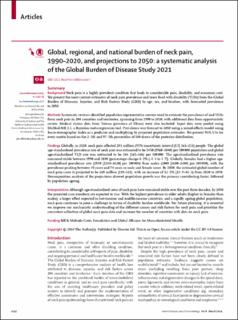| dc.contributor.author | Neck Pain Collaborators, GBD 2021 | |
| dc.contributor.author | GBD 2021 Neck Pain Collaborators | |
| dc.date.accessioned | 2024-04-08T08:06:14Z | |
| dc.date.available | 2024-04-08T08:06:14Z | |
| dc.date.created | 2024-02-20T13:10:45Z | |
| dc.date.issued | 2024 | |
| dc.identifier.citation | The Lancet Rheumatology. 2024, (6), e142-e155. | en_US |
| dc.identifier.uri | https://hdl.handle.net/11250/3125198 | |
| dc.description.abstract | Background
Neck pain is a highly prevalent condition that leads to considerable pain, disability, and economic cost. We present the most current estimates of neck pain prevalence and years lived with disability (YLDs) from the Global Burden of Diseases, Injuries, and Risk Factors Study (GBD) by age, sex, and location, with forecasted prevalence to 2050.
Methods
Systematic reviews identified population-representative surveys used to estimate the prevalence of and YLDs from neck pain in 204 countries and territories, spanning from 1990 to 2020, with additional data from opportunistic review. Medical claims data from Taiwan (province of China) were also included. Input data were pooled using DisMod-MR 2.1, a Bayesian meta-regression tool. Prevalence was forecast to 2050 using a mixed-effects model using Socio-demographic Index as a predictor and multiplying by projected population estimates. We present 95% UIs for every metric based on the 2·5th and 97·5th percentiles of 100 draws of the posterior distribution.
Findings
Globally, in 2020, neck pain affected 203 million (95% uncertainty interval [UI] 163–253) people. The global age-standardised prevalence rate of neck pain was estimated to be 2450 (1960–3040) per 100 000 population and global age-standardised YLD rate was estimated to be 244 (165–346) per 100 000. The age-standardised prevalence rate remained stable between 1990 and 2020 (percentage change 0·2% [–1·3 to 1·7]). Globally, females had a higher age-standardised prevalence rate (2890 [2330–3620] per 100 000) than males (2000 [1600–2480] per 100 000), with the prevalence peaking between 45 years and 74 years in male and female sexes. By 2050, the estimated global number of neck pain cases is projected to be 269 million (219–322), with an increase of 32·5% (23·9–42·3) from 2020 to 2050. Decomposition analysis of the projections showed population growth was the primary contributing factor, followed by population ageing.
Interpretation
Although age-standardised rates of neck pain have remained stable over the past three decades, by 2050 the projected case numbers are expected to rise. With the highest prevalence in older adults (higher in females than males), a larger effect expected in low-income and middle-income countries, and a rapidly ageing global population, neck pain continues to pose a challenge in terms of disability burden worldwide. For future planning, it is essential we improve our mechanistic understanding of the different causes and risk factors for neck pain and prioritise the consistent collection of global neck pain data and increase the number of countries with data on neck pain. | en_US |
| dc.language.iso | eng | en_US |
| dc.rights | Navngivelse 4.0 Internasjonal | * |
| dc.rights.uri | http://creativecommons.org/licenses/by/4.0/deed.no | * |
| dc.subject | Neck pain | en_US |
| dc.subject | Prevalence | en_US |
| dc.subject | Years lived with disability | en_US |
| dc.subject | Global Burden of Diseases | en_US |
| dc.title | Global, regional, and national burden of neck pain, 1990–2020, and projections to 2050: a systematic analysis of the Global Burden of Disease Study 2021 | en_US |
| dc.title.alternative | Global, regional, and national burden of neck pain, 1990–2020, and projections to 2050: a systematic analysis of the Global Burden of Disease Study 2021 | en_US |
| dc.type | Peer reviewed | en_US |
| dc.type | Journal article | en_US |
| dc.description.version | publishedVersion | en_US |
| dc.source.pagenumber | e142-e155 | en_US |
| dc.source.volume | 6 | en_US |
| dc.source.journal | The Lancet Rheumatology | en_US |
| dc.identifier.doi | 10.1016/S2665-9913(23)00321-1 | |
| dc.identifier.cristin | 2248048 | |
| cristin.ispublished | true | |
| cristin.fulltext | original | |
| cristin.qualitycode | 1 | |

